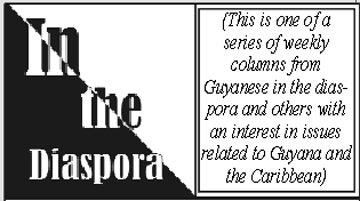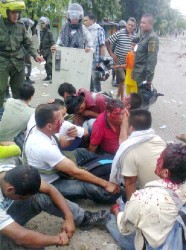By Andy Higginbottom
Andy Higginbotham is Secretary of the Colombia Solidarity Campaign and Principal Lecturer at Kingston University, London
 Editor’s Note: This is an adapted version of an essay that was carried on the 1804 Caribvoices blog (http://1804caribvoices.org) Caribbean economist Norman Girvan reflects on the importance and relevance of this popular strike for the Caribbean: “The struggle of Colombian small farmers against cheap agricultural imports from the USA resulting from a FTA has lessons for the Caribbean. In the 2001 film Life and Debt, we saw how Jamaican dairy farmers were forced to dump fresh milk because of cheap subsidised milk powder from the European Union after imports were liberalised. Banana exports have been undercut by World Trade Organization rulings driven by the same Free Trade philosophy. Now Caricom is negotiating an FTA with Canada and it is expected that an FTA with the US will follow. Caricom agriculturalists need to watch these developments very closely and be prepared to act to defend their interests in any future FTAs, as the Colombian farmers are doing.”
Editor’s Note: This is an adapted version of an essay that was carried on the 1804 Caribvoices blog (http://1804caribvoices.org) Caribbean economist Norman Girvan reflects on the importance and relevance of this popular strike for the Caribbean: “The struggle of Colombian small farmers against cheap agricultural imports from the USA resulting from a FTA has lessons for the Caribbean. In the 2001 film Life and Debt, we saw how Jamaican dairy farmers were forced to dump fresh milk because of cheap subsidised milk powder from the European Union after imports were liberalised. Banana exports have been undercut by World Trade Organization rulings driven by the same Free Trade philosophy. Now Caricom is negotiating an FTA with Canada and it is expected that an FTA with the US will follow. Caricom agriculturalists need to watch these developments very closely and be prepared to act to defend their interests in any future FTAs, as the Colombian farmers are doing.”
Last month’s ‘paro agrario nacional’ was the biggest national agricultural strike in Colombia since 1977. It was a momentous struggle during which twelve small farmer campesino protestors were killed, four have been ‘disappeared’, nearly five hundred wounded and over six hundred detained.
This column examines the effect of Free Trade Agreements (FTAs) as the principle cause of the strike, the repression faced by the campesinos and considers where the paro leaves Colombia now.
Colombia’s FTAs – a disaster foretold
Colombia’s President Santos says ‘there will be winners and losers with free trade’. The reality of his country’s shifting trade pattern with the NAFTA countries (US, Canada, Mexico) indicates how much is being lost, and how little won. The Colombia US FTA came into force on 15 May 2012. Amongst the few winners are businesses exporting garments into the US market who saw their trade increase by around 12 per cent between the first half of 2012 and 2013. Over the same period agriculture exports to the US increased marginally, from $46 million to $48 million, but agricultural imports from the US more than doubled, from $177million to $352 million.
Some business sectors want more supportive industrial policies, such as Colombia’s vehicle manufacturers whose domestic market and position as supplier to its Andean neighbours is threatened by a huge increase in imports from Mexico and Korea. Other businesses that are in favour of free trade in principle believe the problem lies with the negligent manner that the Colombia’s previous Uribe government carried out the FTA negotiations. This is especially argued by the pharmaceutical industry who will confront US dictated intellectual property and patent laws.
Agriculture has been the hardest hit by the increase of imports, not only from the US but from competing exporters in other Andean countries and in Mercosur. There will be even more competition, as the FTA with the EU only came into effect on 1 August 2013. The politician most consistently opposed to the FTAs, Senator Jorge Robledo of the opposition Polo Democrático, observed that “it’s better to be a cow in the EU than a peasant in Colombia, they get more state subsidies”.

Paro Nacional: Chronicle of an Uprising
Starting officially on 19 August, the ‘paro nacional agarario’ national agricultural strike was already the confluence of waves of strikes by coffee growers, and other farmers growing rice, cotton, maize, potatoes and onions in different regions in February this year. The government entered a series of sector agreements in March, generally promising price support and credit; but had failed to fulfil its commitments. The small farmers had gone back to work but their condition remained untenable, the price of inputs greater than the price they can sell their crops. The peasants had reached their limit, and could endure no more. They came onto the highways and blocked them, bringing most of the country and increasingly the capital Bogotá to a halt.
The campesino ruana poncho cloak became the strike’s symbol. With protests in 22 of Colombia’s 34 departments, the strike was particularly strong in Catatumbo and other areas not previously known for their militancy: the dairy, potato and onion farmers of Boyacá and Nariño, and the rice growers in Huila.
One of the conditions that former US President Bush and then President Obama put on passing the FTA is that Colombia would pass a law to privatise seeds. This was carried out by the government agency ICA which passed Decree 9.70 in 2010 setting the condition that only certified seeds can be sown. The trouble is only big capital, the multinationals, can afford the certification process. 9.70 became notorious as the ‘Monsanto Law.’, The subject of a documentary by Victoria Solano that had a big impact on public opinion, it shows rice farmers in Campoalegre weeping as their seed stock is destroyed, the police attacking their protests and ICA official justifying their actions.
The 2013 strike was a confluence involving agricultural day labourers, small and medium farmers and other workers. The three main campesino organisations worked in coordination, but each putting forward their own set of demands, albeit with mostly common elements such the demand to suspend and renegotiate the FTAs. Truck drivers and artisan miners joined the strike and their demands were included in local and regional platforms.
For example, in the town of Cajamarca in central Tolima department, small farmers’ water supplies are threatened by La Colosa, a huge open-cast gold mine proposed by the South African based corporation AngloGold Ashanti. In this region the peasants’ specific demands were:
1. No Mining in Cajamarca and Tolima. No to La Colosa
2. Reject foreign ownership of land, especially the
purchases being made by Anglogold in Cajamarca.
3. Control of prices and subsidies for agricultural supplies.
4. Demand of social security, health and pensions for campesinos.
5. Regulation of the intermediaries between producers and consumers.
6. Participation of Campesinos from Cajamarca in the national platform.
This community’s concerns touch on another aspect of the free trade agreements which is yet to be fully revealed to Colombians, the extent to which their articles protecting investor rights and profits will hamper environmental and social protection in the future.
Representative of the national picture, from one small town five thousand peasants went on a peaceful march on the main highway linking Bogotá with the western cities and export routes. The repression they received is also typical. An eyewitness reports:
“As night arrived the campesinos retired to the town were they stayed over with local residents. At around 2am the riot police ESMAD arrived and maltreated the community. They shot tear gas and rubber bullets at us putting people in a daze, then they hit us with their rifle butts. The police took away thirty people who had been sleeping in the primary school, exhausted from their arduous day”.
Source: Consciencia Campesina
Local campesino leaders were declared targets and specially attacked by the police for physical injury and detentions. In Castilla, in the same department, a report by the Colombia Solidarity Campaign noted that the police
“destroyed and looted the campesinos’ food stores, invaded homes, knocked down doors in order to drag campesinos out of their homes, and have obstructed the movement of people on public roads. On the 20th August the community was bombarded with tear gas from helicopters, choking the elderly and infants and damaging homes”.
News of such assaults spread rapidly. TV journalist Holman Morris ran an entire programme of social media clips showing police brutality. By late August the situation in the country had become extremely tense. The social commotion reached Bogotá, where flying pickets stopped the movement of goods at Corabastos, the country’s main wholesale food market. Food prices in the shops doubled.
The third week into the strike was the decisive moment. Despite the repression the campesinos had kept their dignity and were not backing down, and with urban social sectors coming out too, state forces risked becoming overstretched. Politically, the government was clearly losing the middle ground. The Catholic bishop of Tunja declared his support of the strike, “sometimes expressions of anger are needed when there is no other way to make a negative situation visible”. The government had to find a solution and, eighteen days into the strike, Santos declared there would be a ‘National Pact’ for the agricultural sector and sought to enter into regional negotiations. The campesino movement rejected both these proposals as manoeuvres and kept up the pressure.
On 8 September the government committed to not applying Decree 9.70, so allowing small rice growers to use their own seed, but there are already signs of backsliding – the exception is for holdings of just five hectares or less. The government did not agree to suspend or renegotiate the FTAs, but it did promise to release all detained protestors, a new mining law and compensation payments on milk and other products for two years, and to hold negotiations with the campesino representatives. That was enough to lift the road blocks, for now.
What next?
The paro agrario has forced into public attention the structural crisis confronting the rural poor in Colombia, which is now undeniable. The paro is a major step forward within a broader pattern of recovery of the social movements to a level that has not been seen since the 1970s. Last year the student movement wrung a similar back down from Santos on higher education reform – it took a month long national strike involving the mobilisation of half a million university and high school students to force the government into negotiations. The students created a common front, MANE, and are preparing to re-engage their fight. What these mobilisations show is that the future of Colombia cannot be decided democratically except with the direct participation of the social movements.
Santos still does not admit that the free trade agreements further polarise an already divided Colombian society. At the lowest ever rating in the poll, he has been forced into a tactical retreat, but not a change in strategy. Like Uribe before him, Santos is committed to a programme of deepening the neoliberal free trade regime. Colombia has signed fourteen FTAs in all. It has with Mexico, Peru and Chile consolidated the pro-free trade Alianza Pacífico grouping, and is with them committed to entering the Trans-Pacific Partnership (TPP) free trade agreement linking the US, Japan and nine other countries.
Popular class struggle to defeat the Colombia’s FTAs has begun. The sustained mobilisation of the peasant movement won over the country at large against the initial hostility of the mass media. But the government, congress, big business and the security state are still against them. The campesinos are aware they risk losing out in the machinations of negotiation and government procrastination. Two of the three main currents in the peasant movement held a national summit on 12 September ‘to share reflections’ on the strike, and to convene a wider conference in October. They may need to return to the highways once again.
For further information, see (The Colombia government sows terror
http://www.colombiasolidarity.org.uk/articles/52-comment/599-the-colombian-government-sows-terror-the-cases-of-cajamarca-and-castilla-tolima





